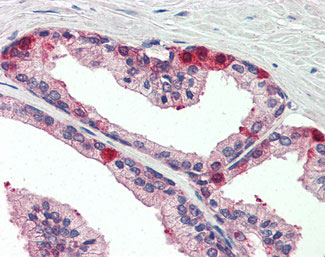TAOK3 / JIK Antibody (Internal)
Goat Polyclonal Antibody
- SPECIFICATION
- CITATIONS
- PROTOCOLS
- BACKGROUND

Application
| WB, IHC-P, E |
|---|---|
| Primary Accession | Q9H2K8 |
| Reactivity | Human, Rabbit, Pig, Horse, Bovine |
| Host | Goat |
| Clonality | Polyclonal |
| Calculated MW | 105kDa |
| Dilution | ELISA (1:32000), IHC-P (2-3 µg/ml), WB (1:32000) |
| Gene ID | 51347 |
|---|---|
| Other Names | Serine/threonine-protein kinase TAO3, 2.7.11.1, Cutaneous T-cell lymphoma-associated antigen HD-CL-09, CTCL-associated antigen HD-CL-09, Dendritic cell-derived protein kinase, JNK/SAPK-inhibitory kinase, Jun kinase-inhibitory kinase, Kinase from chicken homolog A, hKFC-A, Thousand and one amino acid protein 3, TAOK3, DPK, JIK, KDS, MAP3K18 |
| Target/Specificity | Human TAOK3. |
| Reconstitution & Storage | Store at -20°C. Minimize freezing and thawing. |
| Precautions | TAOK3 / JIK Antibody (Internal) is for research use only and not for use in diagnostic or therapeutic procedures. |
| Name | TAOK3 |
|---|---|
| Synonyms | DPK, JIK, KDS, MAP3K18 |
| Function | Serine/threonine-protein kinase that acts as a regulator of the p38/MAPK14 stress-activated MAPK cascade and of the MAPK8/JNK cascade. In response to DNA damage, involved in the G2/M transition DNA damage checkpoint by activating the p38/MAPK14 stress-activated MAPK cascade, probably by mediating phosphorylation of upstream MAP2K3 and MAP2K6 kinases. Inhibits basal activity of the MAPK8/JNK cascade and diminishes its activation in response to epidermal growth factor (EGF). Positively regulates canonical T cell receptor (TCR) signaling by preventing early PTPN6/SHP1-mediated inactivation of LCK, ensuring sustained TCR signaling that is required for optimal activation and differentiation of T cells (PubMed:30373850). Phosphorylates PTPN6/SHP1 on 'Thr-394', leading to its polyubiquitination and subsequent proteasomal degradation (PubMed:38166031). Required for cell surface expression of metalloprotease ADAM10 on type 1 transitional B cells which is necessary for their NOTCH-mediated development into marginal zone B cells (By similarity). Also required for the NOTCH-mediated terminal differentiation of splenic conventional type 2 dendritic cells (By similarity). Positively regulates osteoblast differentiation by acting as an upstream activator of the JNK pathway (PubMed:32807497). Promotes JNK signaling in hepatocytes and positively regulates hepatocyte lipid storage by inhibiting beta-oxidation and triacylglycerol secretion while enhancing lipid synthesis (PubMed:34634521). Restricts age-associated inflammation by negatively regulating differentiation of macrophages and their production of pro- inflammatory cytokines (By similarity). Plays a role in negatively regulating the abundance of regulatory T cells in white adipose tissue (By similarity). |
| Cellular Location | Cytoplasm. Cell membrane; Peripheral membrane protein. Membrane raft. Lipid droplet. Note=Located primarily outside cell membrane rafts and remains outside upon canonical TCR ligation (PubMed:30373850). A small pool is detectable in cell membrane rafts in resting conditions but relocates outside the rafts upon TCR signaling (PubMed:30373850). Localizes to lipid droplets in hepatocytes (PubMed:34634521). |
| Tissue Location | Ubiquitously expressed at a low level, and highly expressed in peripheral blood leukocytes (PBLs), thymus, spleen, kidney, skeletal muscle, heart and liver. |

Thousands of laboratories across the world have published research that depended on the performance of antibodies from Abcepta to advance their research. Check out links to articles that cite our products in major peer-reviewed journals, organized by research category.
info@abcepta.com, and receive a free "I Love Antibodies" mug.
Provided below are standard protocols that you may find useful for product applications.
Background
Serine/threonine-protein kinase that acts as a regulator of the p38/MAPK14 stress-activated MAPK cascade and of the MAPK8/JNK cascade. Acts as an activator of the p38/MAPK14 stress- activated MAPK cascade. In response to DNA damage, involved in the G2/M transition DNA damage checkpoint by activating the p38/MAPK14 stress-activated MAPK cascade, probably by mediating phosphorylation of upstream MAP2K3 and MAP2K6 kinases. Inhibits basal activity of MAPK8/JNK cascade and diminishes its activation in response epidermal growth factor (EGF).
References
Tassi E.,et al.J. Biol. Chem. 274:33287-33295(1999).
Zhang W.,et al.Biochem. Biophys. Res. Commun. 274:872-879(2000).
Yustein J.T.,et al.Oncogene 22:6129-6141(2003).
Carter T.G.,et al.Submitted (AUG-1999) to the EMBL/GenBank/DDBJ databases.
Kalnine N.,et al.Submitted (MAY-2003) to the EMBL/GenBank/DDBJ databases.
If you have used an Abcepta product and would like to share how it has performed, please click on the "Submit Review" button and provide the requested information. Our staff will examine and post your review and contact you if needed.
If you have any additional inquiries please email technical services at tech@abcepta.com.













 Foundational characteristics of cancer include proliferation, angiogenesis, migration, evasion of apoptosis, and cellular immortality. Find key markers for these cellular processes and antibodies to detect them.
Foundational characteristics of cancer include proliferation, angiogenesis, migration, evasion of apoptosis, and cellular immortality. Find key markers for these cellular processes and antibodies to detect them. The SUMOplot™ Analysis Program predicts and scores sumoylation sites in your protein. SUMOylation is a post-translational modification involved in various cellular processes, such as nuclear-cytosolic transport, transcriptional regulation, apoptosis, protein stability, response to stress, and progression through the cell cycle.
The SUMOplot™ Analysis Program predicts and scores sumoylation sites in your protein. SUMOylation is a post-translational modification involved in various cellular processes, such as nuclear-cytosolic transport, transcriptional regulation, apoptosis, protein stability, response to stress, and progression through the cell cycle. The Autophagy Receptor Motif Plotter predicts and scores autophagy receptor binding sites in your protein. Identifying proteins connected to this pathway is critical to understanding the role of autophagy in physiological as well as pathological processes such as development, differentiation, neurodegenerative diseases, stress, infection, and cancer.
The Autophagy Receptor Motif Plotter predicts and scores autophagy receptor binding sites in your protein. Identifying proteins connected to this pathway is critical to understanding the role of autophagy in physiological as well as pathological processes such as development, differentiation, neurodegenerative diseases, stress, infection, and cancer.



